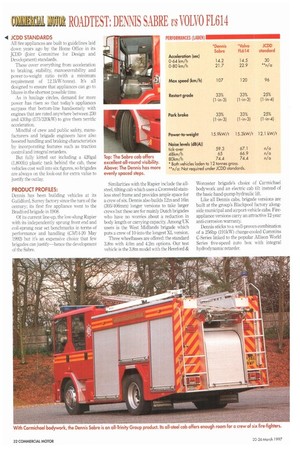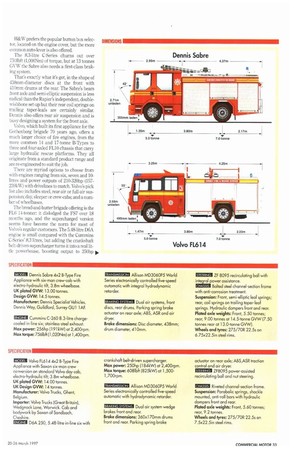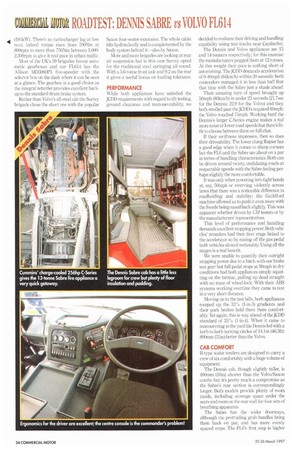ti I ROADTEST: DENNIS SABRE vs VOLVO FL614
Page 34

Page 35

Page 36

Page 37

If you've noticed an error in this article please click here to report it so we can fix it.
All the appliances are built to guidelines laid down years ago by the Home Office in its JCDD (Joint Committee for Design and Development) standards.
These cover everything from acceleration to braking, stability, manoeuvrability and power-to-weight ratio (with a minimum requirement of 12.1kWitonne). It's all designed to ensure that appliances can go to blazes in the shortest possible time.
As in haulage circles, demand for more power has risen so that today's appliances surpass that bottom-line handsomely with engines that are rated anywhere between 230 and 430hp (175/320kW) to give them terrific acceleration.
Mindful of crew and public safety, manufacturers and brigade engineers have also boosted handling and braking characteristics by incorporating features such as traction control and integral retarders.
But fully kitted out including a 420gal (1,8001it) plastic tank behind the cab, these vehicles cost well into six figures, so brigades are always on the look-out for extra value to justify the outlay.
Dennis has been building vehicles at its Guildford, Surrey factory since the turn of the century; its first fire appliance went to the Bradford brigade in 1908.
Of its current line-up, the low-slung Rapier with its independently sprung front end and coil-sprung rear set benchmarks in terms of performance and handling (CMI4-20 May 1992) but it's an expensive choice that few brigades can justify—hence the development of the Sabre. Similarities with the Rapier include the allsteel, tilting cab which uses a Cromweld stainless steel frame and provides ample space for a crew of six. Dennis also builds 12in and 16in (305/406mm) longer versions to take larger crews but these are for mainly Dutch brigades who have no worries about a reduction in body length or carrying capacity. Among LI{ users is the West Midlands brigade which puts a crew of 10 into the longest XL version.
Three vvheelbases are offered: the standard 3.8m with 4.0m and 42m options. Our test vehicle is the 3.8m model with the Hereford & Worcester brigade's choice of Carmichael bodywork and an electric (21) tilt instead of the basic hand-pump hydraulic lift.
Like all Dennis cabs, brigade versions are built at the group's Blackpool factory alongside municipal and airport-vehicle cabs. Fireappliance versions carry an attractive 12-year anti-corrosion warranty.
Dennis sticks to a well-proven combination of a 256hp (191kVii) charge-cooled Cummins C-Series linked to the popular Allison World Series five-speed auto box with integral hydrodynamic retarder. B&W prefers the popular button box selector, located on the engine cover, but the more common auto-lever is also offered.
The 8.3-litre C-Series churns out over 750Ibft (1,000Nm) of torque, but at 13 tonnes GVW the Sabre also needs a first-class braking system.
That's exactly what it's got, in the shape of 438mm-diameter discs at the front with 410mm drums at the rear. The Sabre's beam front axle and semi-elliptic suspension is less radical than the Rapier's independent, doublewishbone set-up but their rear coil springs on trailing taper-leafs are certainly similar. Dennis also offers rear air suspension and is busy designing a system for the front axle.
Volvo, which built its first appliance for the Gothenberg brigade 70 years ago, offers a much larger choice of fire engines, from the more common 14 and 17-tonne B-Types to three and four-axled FL10 chassis that carry large hydraulic rescue platforms. They all originate from a standard product range and are re-engineered to suit the job.
There are myriad options to choose from with engines ranging from six, seven and 10litres and power outputs of 210-320hp (157239kW) with drivelines to match. Volvo's pick list also includes steel, rear-air or full-air suspension: day, sleeper or crew-cabs; and a number of wheelbases.
The bread-and-butter brigade offering is the 116 14-tonner: it dislodged the FS7 over 18 months ago, and the supercharged version seems have become the norm for most of Volvo's regular customers. The 5.48-litre D6A engine is small compared with the Cummins C-Series' 8.3 litres, but adding the crankshaft belt-driven supercharger turns it into a real little powerhouse, boosting output to 250hp
(184kW). There's no turbocharger lag at low revs; indeed torque rises from 700Nm at 800rpm to more than 750Nm between 1,00023(X)rpm to give it real pace in urban traffic.
Most of the UK's 59 brigades favour automatic gearboxes and our F1,614 has the Allison MD3060P5 five-speeder with the selector box on the dash where it can be seen at a glance. The gearbox is a good choice as the integral retarder provides excellent backup to the standard drum brake system.
Rather than Volvo's all-steel cab the Surrey brigade chose the short one with the popular Saxon four-seater extension. The whole cabin tilts hydraulically and is complemented by the body system behind it—also by Saxon.
More and more brigades are looking at rear air suspension but in this case Surrey opted for the traditional steel springing all round. With a 5.6-tonne front axle and 9.2 on the rear it gives a useful bonus on loading tolerance.
While both appliances have satisfied the JCDD requirements with regard to tilt testing, ground clearance and tnanouevrability, we
decided to evaluate their driving and handling capability using test tracks near Camberley.
The Dennis and Volvo appliances are 13 and 14-tonners respectively; for this exercise the manufacturers pegged them at 12 tonnes. At this weight their pace is nothing short of astonishing. The JCDD demands acceleration of 0-40mph (64km/h) within 30 seconds: both contenders managed it in less than half that that time with the Sabre just a shade ahead.
Their amazing turn of speed brought up 50mph (80km/h) in under 23 seconds (21.7sec for the Dennis: 22.9 for the Volvo) and they both strolled past the JCDDS required 60mph: the Volvo touched 75mph. Working hard the Dennis's larger C-Series engine makes a tad more noise at lower road speeds but there's little to choose between them on full chat.
If their swiftness impresses, then so does their driveability. The lower slung Rapier has a good edge when it comes to sharp corners but the FL6 and the Sabre are about on a par in terms of handling characteristics. Both can be driven around twisty, undulating roads at respectable speeds with the Sabre feeling perhaps slightly the more comfortable.
It was only when powering into tight bends at, say, 50mph or swerving violently across lanes that there was a noticeable difference in roadholding and stability; the Guildford machine allowed us to push it even more with the Swede being eased back slightly. This was apparent whether driven by CM testers or by the manufacturers' representatives.
This level of performance and handling demands excellent stopping power. Both vehicles' retarders had their first stage linked to the accelerator so by easing off the gas pedal both vehicles slowed noticeably. Using all the stages is a real benefit.
We were unable to quantify their outright stopping power due to a hitch with our brake test gear but full pedal stops at 50mph in dry conditions had both appliances simply squatting on the tarmac, pulling up dead straight with no trace of wheel-lock. With their ABS systems working overtime they came to rest in a very short distance.
Moving on to the test hills, both appliances romped up the 33% (1-in-3) gradients and their park brakes held them there comfortably Yet again, this is way ahead of the JCDD standard of 25% (1-in-4). When it came to manouevring in the yard the Dennis led with a kerb-to-kerb turning circles of 14.1m (46.3ft): 800mm (31in) better than the Volvo.
B-type water tenders are designed to carry a crew of six comfortably with a huge volume of equipment.
The Dennis cab, though slightly taller, is 400mm (16in) shorter than the Volvo/Saxon combo but it's pretty much a compromise as the Sabre's rear section is correspondingly longer. Both models provide plenty of room inside, including stowage space under the scats and room on the rear wall for four sets of breathing apparatus.
The Sabre has the wider doorways, although the protruding grab handles bring them back on par, and has more evenly spaced steps. The FL6's first step is higher than on the Dennis hut once inside both cabs are roomy enough to let the crew don protective gear, and their doorways are high and wide enough to allow fast, unimpeded entry and exit.
Both look capable of protecting the crew from frontal impacts but there's something comforting about Dennis's all-steel cab when masonry is coming down from above.
Commanders are well catered for with banks of warning devices, communications gear and extra lights to busy themselves with. Such is the quality of the cab insulation that briefings can be held in a normal speaking voice, even when travelling at high speed.
When it comes to wide side and forward views the Dennis has a deeper windscreen and lower dash-line that lets the driver see more, particularly just ahead of the bumper. In the rear the Volvo has a little more leg space and if there's a slightly gloomy feel at the back its due to the cab's front header section making the screen seem shallower.
Britain's fire engine market is only worth around 300 units in a good year, but appliances are high-value deals, if a little complicated.
Traditionally Dennis has ruled the roost among British brigades but it now ranks alongside Volvo on UK sales— they share around two-thirds of the market. Mercedes and Scania take most of the rest, leaving ERE Leyland Dal and MAN to fight for scraps.
In simple terms the Dennis Sabre is a dedicated appliance with a well-proven driveline. It is covered by a 12-month whole-vehicle warranty with two years on the driveline and 12 years guarantee against cab rust. The Belgian-built Volvo FL6 is a more standard truck-cum-fire fighting vehicle with similar chassis guarantee but only five year's anticorrosion cover.
They're both the nation's favourite alright, but they do cost an arm and a leg.
With all the extra equipment the final bill is in the region of £120,000. Spec-for-spec the Volvo seems to work out around .0,000 cheaper but this can be obscured by adding extra equipment such as power generators, light masts and foam systems. With this in mind vehicle warranties and sales support become very important factors.
While Volvo has a huge dealer network to call on Dennis's smaller support group includes assembly manufacturers like Cumm ns and Allison.
These are high-performance, high-spec machines that are difficult to separate. On overall performance we think the homegrown Sabre has the edge, but the Volvo comes in slighter cheaper. When it comes to picking replacement appliances the brigade engineers will not find it easy to choose between them.
E By Bryan Jarvis
















































































































